Evaluating Talent Pool Gaps and Multisource Assessment Strategies
VerifiedAdded on 2020/04/21
|9
|1629
|79
AI Summary
This report examines the growing concern regarding talent pool gaps in the post-global recession era. Supported by findings from Talent Planning Surveys conducted by CIPD, it identifies various strategies for identifying these gaps. Among them, multisource assessments or 360-degree feedback mechanisms are highlighted for their potential to analyze employee performance comprehensively. The study evaluates both strengths and weaknesses of multisource assessments, noting the accuracy benefits as well as risks like false opinions that may skew results. Additionally, the report considers other HR technologies such as talent management systems and social networking tools as aids in reducing talent gaps. Ultimately, it concludes that while talent gaps persist, proactive measures using these strategies can enhance workforce competency, thereby supporting economic prosperity.
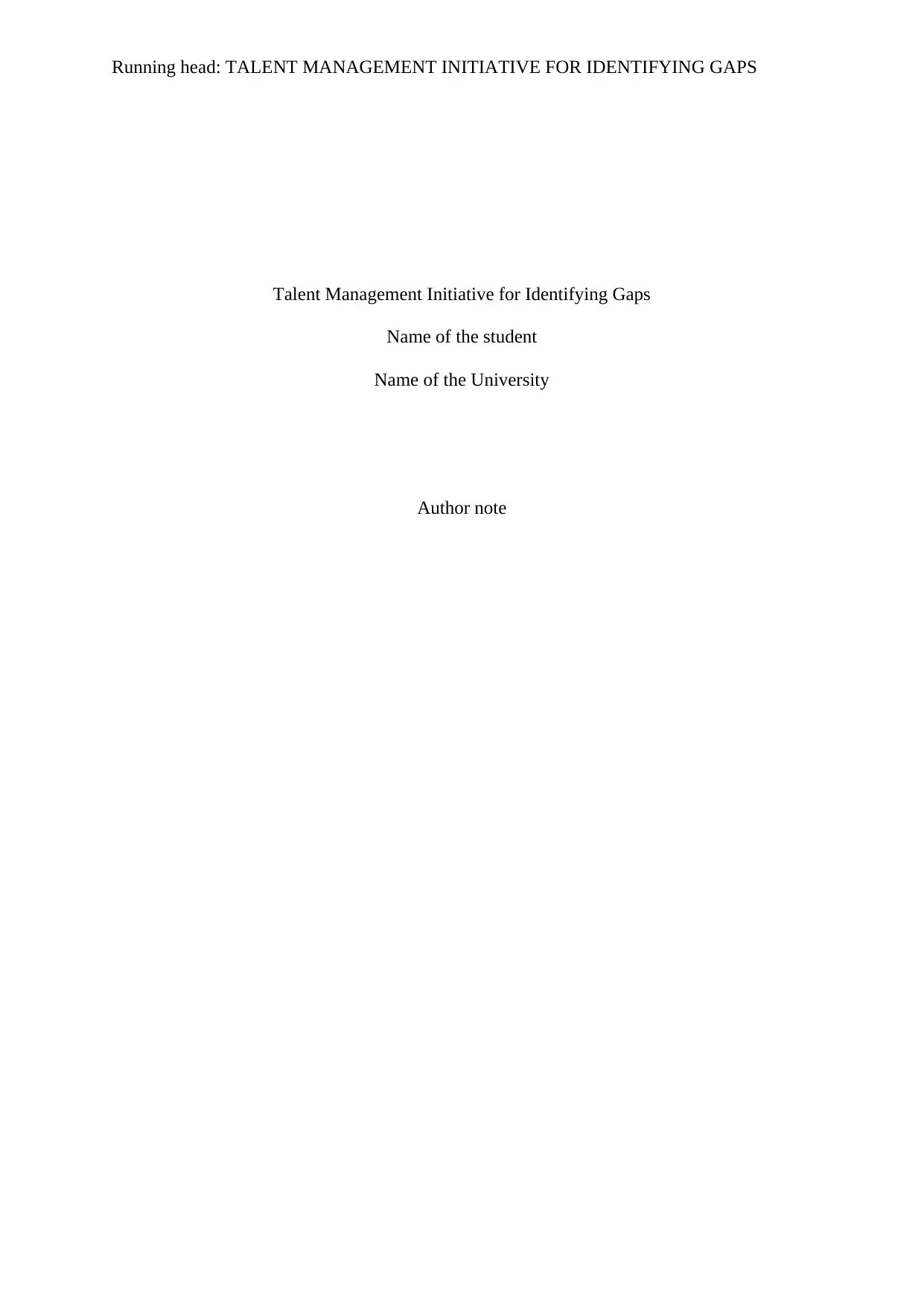
Running head: TALENT MANAGEMENT INITIATIVE FOR IDENTIFYING GAPS
Talent Management Initiative for Identifying Gaps
Name of the student
Name of the University
Author note
Talent Management Initiative for Identifying Gaps
Name of the student
Name of the University
Author note
Paraphrase This Document
Need a fresh take? Get an instant paraphrase of this document with our AI Paraphraser

1TALENT MANAGEMENT INITIATIVE FOR IDENTIFYING GAPS
Executive summary:
Talent management is one of the emerging tasks for the business houses owing to slow
growth of productivity during the post-recession. It is believed that talent gap is a major
reason for this economic trend around the world and this report has discussed various ways to
address it. Over the time new strategies has arisen to define the talent gap in the industry and
among them multisource assessment is a useful one that has been contested in this paper. To
conclude this research has found that talent gap is present in the industry but it is necessary
for the firms to keep evaluating themselves for crowding out the effects on its output and
productivity.
Executive summary:
Talent management is one of the emerging tasks for the business houses owing to slow
growth of productivity during the post-recession. It is believed that talent gap is a major
reason for this economic trend around the world and this report has discussed various ways to
address it. Over the time new strategies has arisen to define the talent gap in the industry and
among them multisource assessment is a useful one that has been contested in this paper. To
conclude this research has found that talent gap is present in the industry but it is necessary
for the firms to keep evaluating themselves for crowding out the effects on its output and
productivity.

2TALENT MANAGEMENT INITIATIVE FOR IDENTIFYING GAPS
Table of Contents
Introduction:...............................................................................................................................3
Some techniques of identifying gaps in talent pool:..................................................................3
Education strategy:.................................................................................................................3
Proactive retraining:...............................................................................................................4
Talent management:...............................................................................................................4
Social networking:.................................................................................................................4
Process of recognizing talent to fill the talent pool gap:............................................................4
Multisource assessment:.............................................................................................................5
Comparison of strengths and weakness of multisource assessment:.........................................5
Conclusion:................................................................................................................................6
Reference:..................................................................................................................................8
Table of Contents
Introduction:...............................................................................................................................3
Some techniques of identifying gaps in talent pool:..................................................................3
Education strategy:.................................................................................................................3
Proactive retraining:...............................................................................................................4
Talent management:...............................................................................................................4
Social networking:.................................................................................................................4
Process of recognizing talent to fill the talent pool gap:............................................................4
Multisource assessment:.............................................................................................................5
Comparison of strengths and weakness of multisource assessment:.........................................5
Conclusion:................................................................................................................................6
Reference:..................................................................................................................................8
⊘ This is a preview!⊘
Do you want full access?
Subscribe today to unlock all pages.

Trusted by 1+ million students worldwide
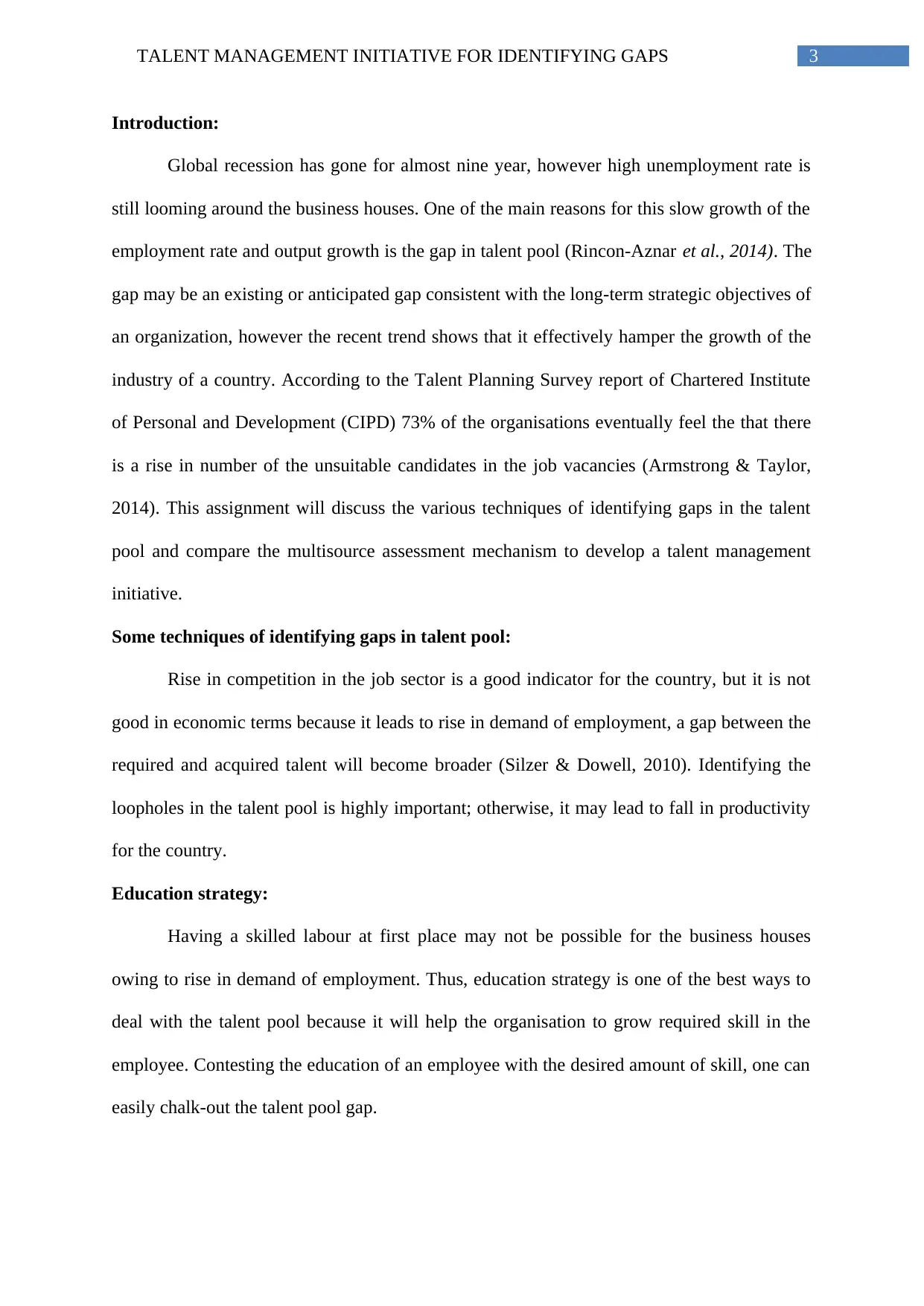
3TALENT MANAGEMENT INITIATIVE FOR IDENTIFYING GAPS
Introduction:
Global recession has gone for almost nine year, however high unemployment rate is
still looming around the business houses. One of the main reasons for this slow growth of the
employment rate and output growth is the gap in talent pool (Rincon-Aznar et al., 2014). The
gap may be an existing or anticipated gap consistent with the long-term strategic objectives of
an organization, however the recent trend shows that it effectively hamper the growth of the
industry of a country. According to the Talent Planning Survey report of Chartered Institute
of Personal and Development (CIPD) 73% of the organisations eventually feel the that there
is a rise in number of the unsuitable candidates in the job vacancies (Armstrong & Taylor,
2014). This assignment will discuss the various techniques of identifying gaps in the talent
pool and compare the multisource assessment mechanism to develop a talent management
initiative.
Some techniques of identifying gaps in talent pool:
Rise in competition in the job sector is a good indicator for the country, but it is not
good in economic terms because it leads to rise in demand of employment, a gap between the
required and acquired talent will become broader (Silzer & Dowell, 2010). Identifying the
loopholes in the talent pool is highly important; otherwise, it may lead to fall in productivity
for the country.
Education strategy:
Having a skilled labour at first place may not be possible for the business houses
owing to rise in demand of employment. Thus, education strategy is one of the best ways to
deal with the talent pool because it will help the organisation to grow required skill in the
employee. Contesting the education of an employee with the desired amount of skill, one can
easily chalk-out the talent pool gap.
Introduction:
Global recession has gone for almost nine year, however high unemployment rate is
still looming around the business houses. One of the main reasons for this slow growth of the
employment rate and output growth is the gap in talent pool (Rincon-Aznar et al., 2014). The
gap may be an existing or anticipated gap consistent with the long-term strategic objectives of
an organization, however the recent trend shows that it effectively hamper the growth of the
industry of a country. According to the Talent Planning Survey report of Chartered Institute
of Personal and Development (CIPD) 73% of the organisations eventually feel the that there
is a rise in number of the unsuitable candidates in the job vacancies (Armstrong & Taylor,
2014). This assignment will discuss the various techniques of identifying gaps in the talent
pool and compare the multisource assessment mechanism to develop a talent management
initiative.
Some techniques of identifying gaps in talent pool:
Rise in competition in the job sector is a good indicator for the country, but it is not
good in economic terms because it leads to rise in demand of employment, a gap between the
required and acquired talent will become broader (Silzer & Dowell, 2010). Identifying the
loopholes in the talent pool is highly important; otherwise, it may lead to fall in productivity
for the country.
Education strategy:
Having a skilled labour at first place may not be possible for the business houses
owing to rise in demand of employment. Thus, education strategy is one of the best ways to
deal with the talent pool because it will help the organisation to grow required skill in the
employee. Contesting the education of an employee with the desired amount of skill, one can
easily chalk-out the talent pool gap.
Paraphrase This Document
Need a fresh take? Get an instant paraphrase of this document with our AI Paraphraser
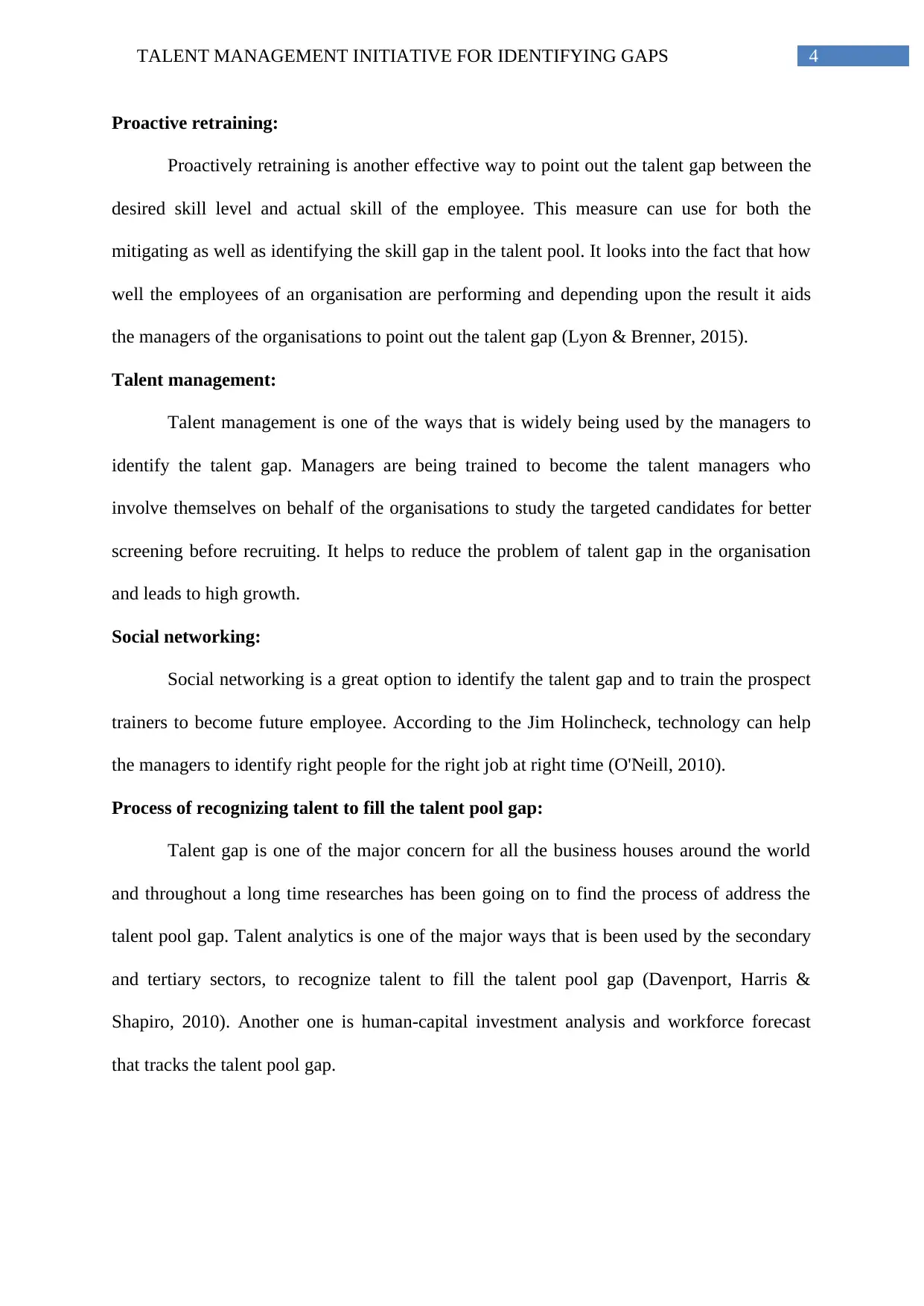
4TALENT MANAGEMENT INITIATIVE FOR IDENTIFYING GAPS
Proactive retraining:
Proactively retraining is another effective way to point out the talent gap between the
desired skill level and actual skill of the employee. This measure can use for both the
mitigating as well as identifying the skill gap in the talent pool. It looks into the fact that how
well the employees of an organisation are performing and depending upon the result it aids
the managers of the organisations to point out the talent gap (Lyon & Brenner, 2015).
Talent management:
Talent management is one of the ways that is widely being used by the managers to
identify the talent gap. Managers are being trained to become the talent managers who
involve themselves on behalf of the organisations to study the targeted candidates for better
screening before recruiting. It helps to reduce the problem of talent gap in the organisation
and leads to high growth.
Social networking:
Social networking is a great option to identify the talent gap and to train the prospect
trainers to become future employee. According to the Jim Holincheck, technology can help
the managers to identify right people for the right job at right time (O'Neill, 2010).
Process of recognizing talent to fill the talent pool gap:
Talent gap is one of the major concern for all the business houses around the world
and throughout a long time researches has been going on to find the process of address the
talent pool gap. Talent analytics is one of the major ways that is been used by the secondary
and tertiary sectors, to recognize talent to fill the talent pool gap (Davenport, Harris &
Shapiro, 2010). Another one is human-capital investment analysis and workforce forecast
that tracks the talent pool gap.
Proactive retraining:
Proactively retraining is another effective way to point out the talent gap between the
desired skill level and actual skill of the employee. This measure can use for both the
mitigating as well as identifying the skill gap in the talent pool. It looks into the fact that how
well the employees of an organisation are performing and depending upon the result it aids
the managers of the organisations to point out the talent gap (Lyon & Brenner, 2015).
Talent management:
Talent management is one of the ways that is widely being used by the managers to
identify the talent gap. Managers are being trained to become the talent managers who
involve themselves on behalf of the organisations to study the targeted candidates for better
screening before recruiting. It helps to reduce the problem of talent gap in the organisation
and leads to high growth.
Social networking:
Social networking is a great option to identify the talent gap and to train the prospect
trainers to become future employee. According to the Jim Holincheck, technology can help
the managers to identify right people for the right job at right time (O'Neill, 2010).
Process of recognizing talent to fill the talent pool gap:
Talent gap is one of the major concern for all the business houses around the world
and throughout a long time researches has been going on to find the process of address the
talent pool gap. Talent analytics is one of the major ways that is been used by the secondary
and tertiary sectors, to recognize talent to fill the talent pool gap (Davenport, Harris &
Shapiro, 2010). Another one is human-capital investment analysis and workforce forecast
that tracks the talent pool gap.

5TALENT MANAGEMENT INITIATIVE FOR IDENTIFYING GAPS
Multisource assessment:
An organisation need designed analytics to crowd out the gap in the talent pool and
the multisource assessment helps to identify the reason of the gap. Multisource assessment,
popularly known as the 360-degree assessment analyzes performance of the employee and his
or her development from the different point of view, considering peers, supervisors,
customers and subordinates (Taylor, 2014). This analysis method collects series data from
different sources regarding the performance of the employee and generated feedback
accordingly. Utilizing the multisource assessment, performance and communication within
the organisation can be enhanced.
Comparison of strengths and weakness of multisource assessment:
Multisource assessment records feedback from the various source including
managers, colleagues, subordinates and customers. Thus, it is a compact an accurate
measurement to assess whether there is any gap in the talent pool of the organisation.
However, multisource assessment of the employee performance is a good way to find out and
mitigate the gap in talent pool but there is a scope of false opinion, which will lead to
improper calculation of the talent gap (Maxim, 2014). Besides this, multisource assessment is
based on technology largely, which leads to slower execution steps in real-life.
Multisource assessment:
An organisation need designed analytics to crowd out the gap in the talent pool and
the multisource assessment helps to identify the reason of the gap. Multisource assessment,
popularly known as the 360-degree assessment analyzes performance of the employee and his
or her development from the different point of view, considering peers, supervisors,
customers and subordinates (Taylor, 2014). This analysis method collects series data from
different sources regarding the performance of the employee and generated feedback
accordingly. Utilizing the multisource assessment, performance and communication within
the organisation can be enhanced.
Comparison of strengths and weakness of multisource assessment:
Multisource assessment records feedback from the various source including
managers, colleagues, subordinates and customers. Thus, it is a compact an accurate
measurement to assess whether there is any gap in the talent pool of the organisation.
However, multisource assessment of the employee performance is a good way to find out and
mitigate the gap in talent pool but there is a scope of false opinion, which will lead to
improper calculation of the talent gap (Maxim, 2014). Besides this, multisource assessment is
based on technology largely, which leads to slower execution steps in real-life.
⊘ This is a preview!⊘
Do you want full access?
Subscribe today to unlock all pages.

Trusted by 1+ million students worldwide
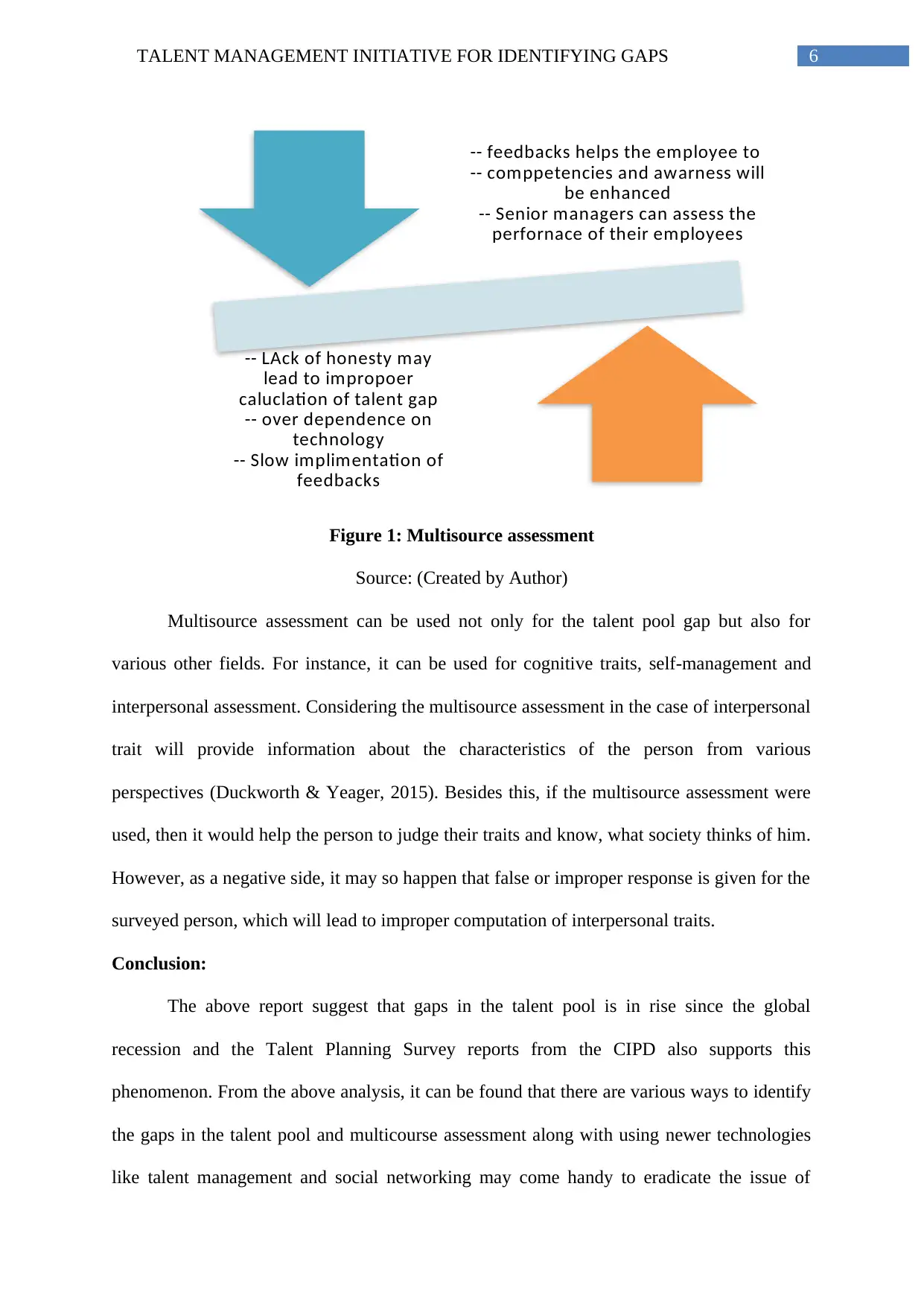
6TALENT MANAGEMENT INITIATIVE FOR IDENTIFYING GAPS
Figure 1: Multisource assessment
Source: (Created by Author)
Multisource assessment can be used not only for the talent pool gap but also for
various other fields. For instance, it can be used for cognitive traits, self-management and
interpersonal assessment. Considering the multisource assessment in the case of interpersonal
trait will provide information about the characteristics of the person from various
perspectives (Duckworth & Yeager, 2015). Besides this, if the multisource assessment were
used, then it would help the person to judge their traits and know, what society thinks of him.
However, as a negative side, it may so happen that false or improper response is given for the
surveyed person, which will lead to improper computation of interpersonal traits.
Conclusion:
The above report suggest that gaps in the talent pool is in rise since the global
recession and the Talent Planning Survey reports from the CIPD also supports this
phenomenon. From the above analysis, it can be found that there are various ways to identify
the gaps in the talent pool and multicourse assessment along with using newer technologies
like talent management and social networking may come handy to eradicate the issue of
-- feedbacks helps the employee to
-- comppetencies and awarness will
be enhanced
-- Senior managers can assess the
perfornace of their employees
-- LAck of honesty may
lead to impropoer
caluclation of talent gap
-- over dependence on
technology
-- Slow implimentation of
feedbacks
Figure 1: Multisource assessment
Source: (Created by Author)
Multisource assessment can be used not only for the talent pool gap but also for
various other fields. For instance, it can be used for cognitive traits, self-management and
interpersonal assessment. Considering the multisource assessment in the case of interpersonal
trait will provide information about the characteristics of the person from various
perspectives (Duckworth & Yeager, 2015). Besides this, if the multisource assessment were
used, then it would help the person to judge their traits and know, what society thinks of him.
However, as a negative side, it may so happen that false or improper response is given for the
surveyed person, which will lead to improper computation of interpersonal traits.
Conclusion:
The above report suggest that gaps in the talent pool is in rise since the global
recession and the Talent Planning Survey reports from the CIPD also supports this
phenomenon. From the above analysis, it can be found that there are various ways to identify
the gaps in the talent pool and multicourse assessment along with using newer technologies
like talent management and social networking may come handy to eradicate the issue of
-- feedbacks helps the employee to
-- comppetencies and awarness will
be enhanced
-- Senior managers can assess the
perfornace of their employees
-- LAck of honesty may
lead to impropoer
caluclation of talent gap
-- over dependence on
technology
-- Slow implimentation of
feedbacks
Paraphrase This Document
Need a fresh take? Get an instant paraphrase of this document with our AI Paraphraser
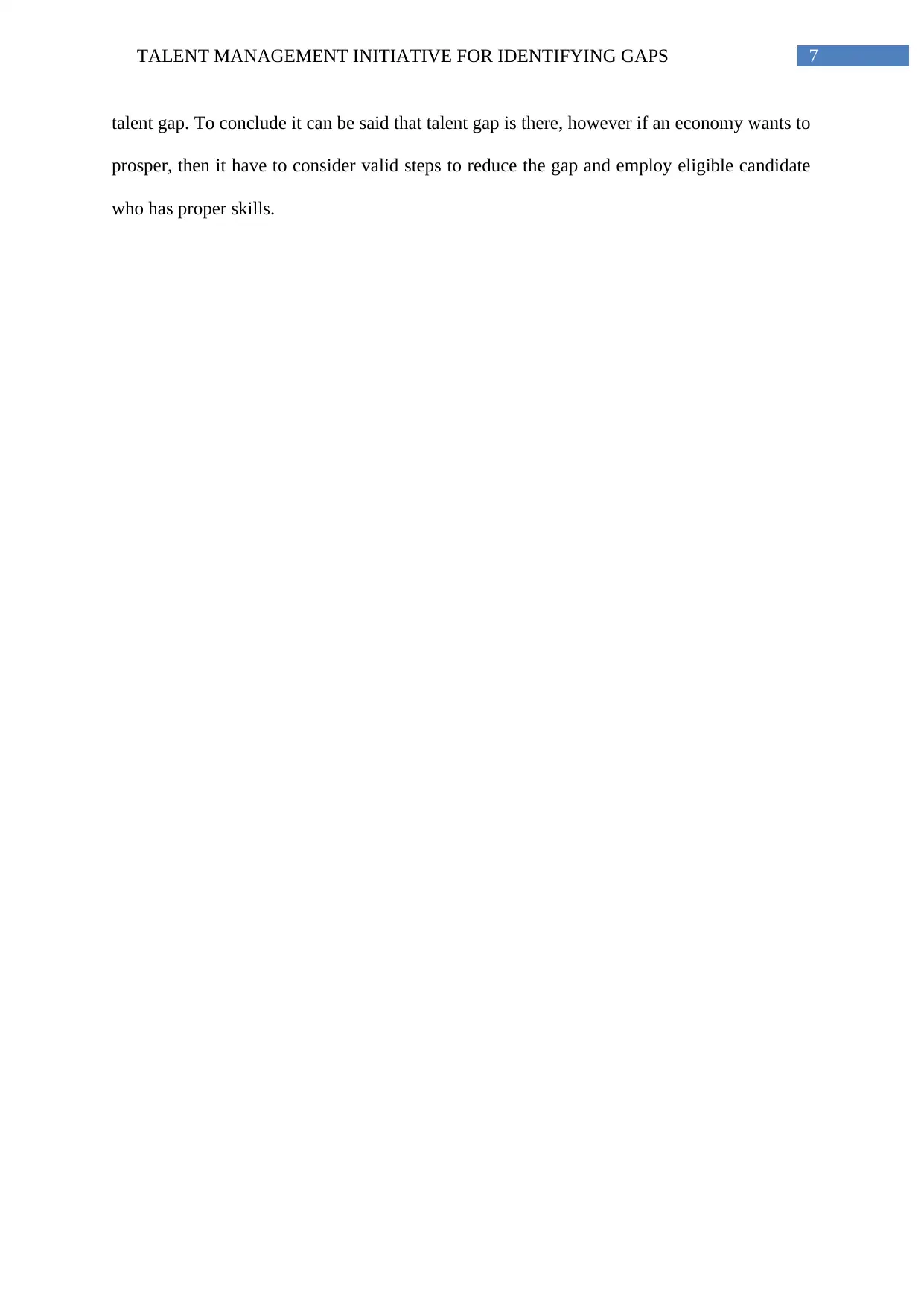
7TALENT MANAGEMENT INITIATIVE FOR IDENTIFYING GAPS
talent gap. To conclude it can be said that talent gap is there, however if an economy wants to
prosper, then it have to consider valid steps to reduce the gap and employ eligible candidate
who has proper skills.
talent gap. To conclude it can be said that talent gap is there, however if an economy wants to
prosper, then it have to consider valid steps to reduce the gap and employ eligible candidate
who has proper skills.
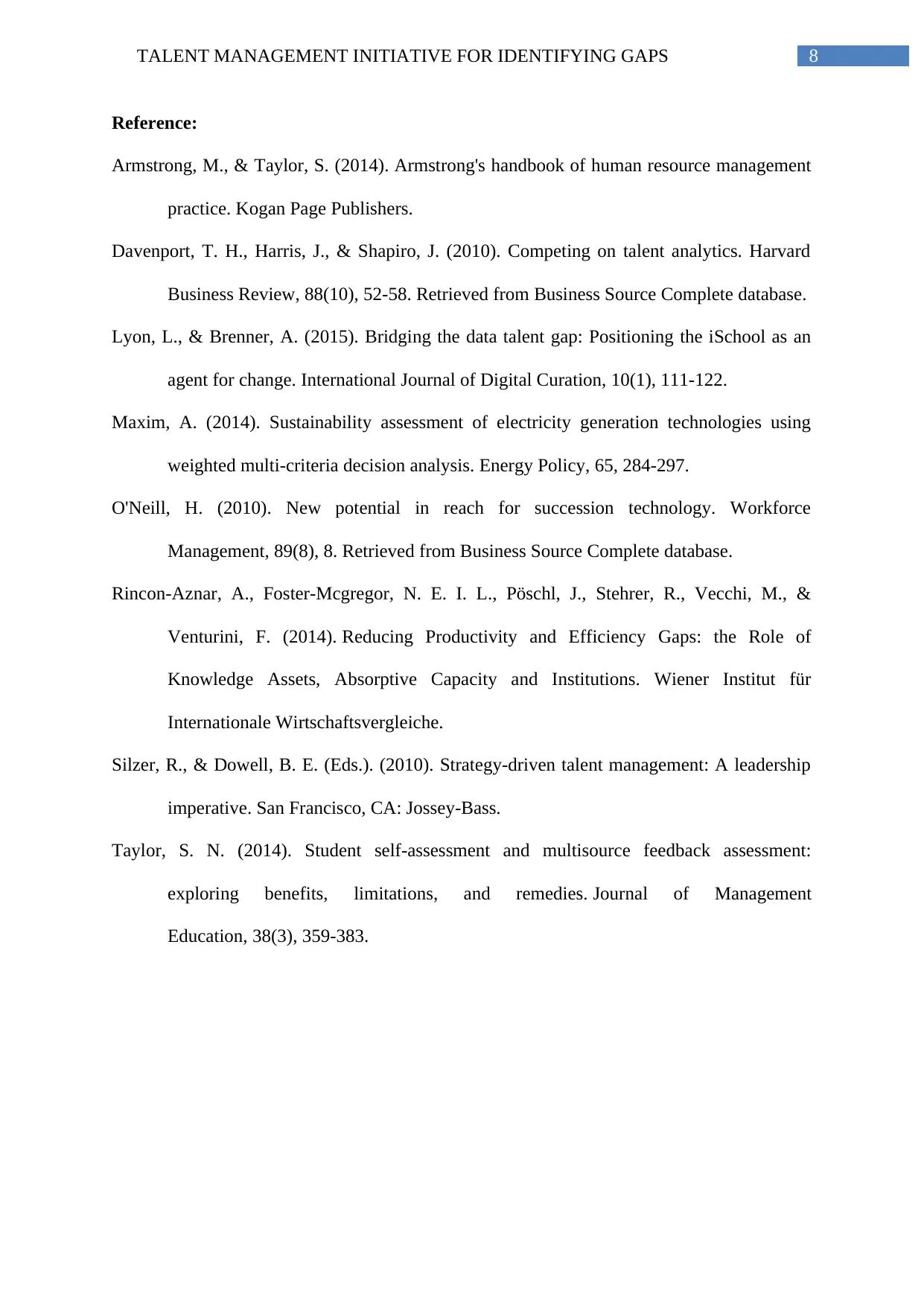
8TALENT MANAGEMENT INITIATIVE FOR IDENTIFYING GAPS
Reference:
Armstrong, M., & Taylor, S. (2014). Armstrong's handbook of human resource management
practice. Kogan Page Publishers.
Davenport, T. H., Harris, J., & Shapiro, J. (2010). Competing on talent analytics. Harvard
Business Review, 88(10), 52-58. Retrieved from Business Source Complete database.
Lyon, L., & Brenner, A. (2015). Bridging the data talent gap: Positioning the iSchool as an
agent for change. International Journal of Digital Curation, 10(1), 111-122.
Maxim, A. (2014). Sustainability assessment of electricity generation technologies using
weighted multi-criteria decision analysis. Energy Policy, 65, 284-297.
O'Neill, H. (2010). New potential in reach for succession technology. Workforce
Management, 89(8), 8. Retrieved from Business Source Complete database.
Rincon-Aznar, A., Foster-Mcgregor, N. E. I. L., Pöschl, J., Stehrer, R., Vecchi, M., &
Venturini, F. (2014). Reducing Productivity and Efficiency Gaps: the Role of
Knowledge Assets, Absorptive Capacity and Institutions. Wiener Institut für
Internationale Wirtschaftsvergleiche.
Silzer, R., & Dowell, B. E. (Eds.). (2010). Strategy-driven talent management: A leadership
imperative. San Francisco, CA: Jossey-Bass.
Taylor, S. N. (2014). Student self-assessment and multisource feedback assessment:
exploring benefits, limitations, and remedies. Journal of Management
Education, 38(3), 359-383.
Reference:
Armstrong, M., & Taylor, S. (2014). Armstrong's handbook of human resource management
practice. Kogan Page Publishers.
Davenport, T. H., Harris, J., & Shapiro, J. (2010). Competing on talent analytics. Harvard
Business Review, 88(10), 52-58. Retrieved from Business Source Complete database.
Lyon, L., & Brenner, A. (2015). Bridging the data talent gap: Positioning the iSchool as an
agent for change. International Journal of Digital Curation, 10(1), 111-122.
Maxim, A. (2014). Sustainability assessment of electricity generation technologies using
weighted multi-criteria decision analysis. Energy Policy, 65, 284-297.
O'Neill, H. (2010). New potential in reach for succession technology. Workforce
Management, 89(8), 8. Retrieved from Business Source Complete database.
Rincon-Aznar, A., Foster-Mcgregor, N. E. I. L., Pöschl, J., Stehrer, R., Vecchi, M., &
Venturini, F. (2014). Reducing Productivity and Efficiency Gaps: the Role of
Knowledge Assets, Absorptive Capacity and Institutions. Wiener Institut für
Internationale Wirtschaftsvergleiche.
Silzer, R., & Dowell, B. E. (Eds.). (2010). Strategy-driven talent management: A leadership
imperative. San Francisco, CA: Jossey-Bass.
Taylor, S. N. (2014). Student self-assessment and multisource feedback assessment:
exploring benefits, limitations, and remedies. Journal of Management
Education, 38(3), 359-383.
⊘ This is a preview!⊘
Do you want full access?
Subscribe today to unlock all pages.

Trusted by 1+ million students worldwide
1 out of 9
Your All-in-One AI-Powered Toolkit for Academic Success.
+13062052269
info@desklib.com
Available 24*7 on WhatsApp / Email
![[object Object]](/_next/static/media/star-bottom.7253800d.svg)
Unlock your academic potential
Copyright © 2020–2025 A2Z Services. All Rights Reserved. Developed and managed by ZUCOL.
